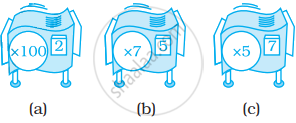Advertisements
Advertisements
Question
A particular star is at a distance of about 8.1 × 1013 km from the Earth. Assuring that light travels at 3 × 108 m per second, find how long does light takes from that star to reach the Earth.
Solution
The distance between Star and Earth = 8.1 × 1013 km = 8.1 × 1013 × 103 m
Since, light travels at 3 × 108 m per second.
So, time taken by light to reach the Earth = `(8.1 xx 10^13 xx 10^3)/(3 xx 10^8)`
= `(8.1 xx 10^16)/(3 xx 10^8)`
= `8.1/3 xx 10^8`
= 2.7 × 108 s
APPEARS IN
RELATED QUESTIONS
The diameter of the Sun is 1.4 × 109 m and the diameter of the Earth is 1.2756 × 107 m.
The table shows the mass of the planets, the sun and the moon in our solar system.
| Celestial Body |
Mass (kg) | Mass (kg) Standard Notation |
| Sun | 1,990,000,000,000,000,000,000,000,000,000 | 1.99 × 1030 |
| Mercury | 330,000,000,000,000,000,000,000 | |
| Venus | 4,870,000,000,000,000,000,000,000 | |
| Earth | 5,970,000,000,000,000,000,000,000 | |
| Mars | 642,000,000,000,000,000,000,000,000,000 | |
| Jupiter | 1,900,000,000,000,000,000,000,000,000 | |
| Saturn | 568,000,000,000,000,000,000,000,000 | |
| Uranus | 86,800,000,000,000,000,000,000,000 | |
| Neptune | 102,000,000,000,000,000,000,000,000 | |
| Pluto | 12,700,000,000,000,000,000,000 | |
| Moon | 73,500,000,000,000,000,000,000 |
- Write the mass of each planet and the Moon in scientific notation.
- Order the planets and the moon by mass, from least to greatest.
- Which planet has about the same mass as earth?
The table shows the average distance from each planet in our solar system to the sun.
| Planet | Distance from Sun (km) |
Distance from Sun (km) Standard Notation |
| Earth | 149,600,000 | 1.496 × 108 |
| Jupiter | 778,300,000 | |
| Mars | 227,900,000 | |
| Mercury | 57,900,000 | |
| Neptune | 4,497,000,000 | |
| Pluto | 5,900,000,000 | |
| Saturn | 1,427,000,000 | |
| Uranus | 2,870,000,000 | |
| Venus | 108,200,000 |
- Complete the table by expressing the distance from each planet to the Sun in scientific notation.
- Order the planets from closest to the sun to farthest from the sun.
This table shows the mass of one atom for five chemical elements. Use it to answer the question given.
| Element | Mass of atom (kg) |
| Titanium | 7.95 × 10–26 |
| Lead | 3.44 × 10–25 |
| Silver | 1.79 × 10–25 |
| Lithium | 1.15 × 10–26 |
| Hydrogen | 1.674 × 10–27 |
- Which is the heaviest element?
- Which element is lighter, Silver or Titanium?
- List all five elements in order from lightest to heaviest.
Two machines can be hooked together. When something is sent through this hook up, the output from the first machine becomes the input for the second. Which two machines hooked together do the same work a (× 102) machine does? Is there more than one arrangement of two machines that will work?

Two machines can be hooked together. When something is sent through this hook up, the output from the first machine becomes the input for the second. Which stretching machine does the same work as two (× 2) machines hooked together?
  |
For the following repeater machines, how many times the base machine is applied and how much the total stretch is?

Shikha has an order from a golf course designer to put palm trees through a (× 23) machine and then through a (× 33) machine. She thinks she can do the job with a single repeater machine. What single repeater machine should she use?

The left column of the chart lists the lengths of input pieces of ribbon. Stretching machines are listed across the top. The other entries are the outputs for sending the input ribbon from that row through the machine from that column. Copy and complete the chart.
| Input Length | Machine | |||
| × 2 | ||||
| 1 | 5 | |||
| 3 | 15 | |||
| 14 | 7 | |||
The distance between the Sun and the Earth is 1.496 × 108 km and distance between the Earth and the Moon is 3.84 × 108 m. During solar eclipse the Moon comes in between the Earth and the Sun. What is distance between the Moon and the Sun at that particular time?
